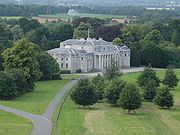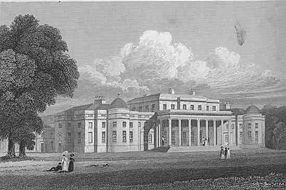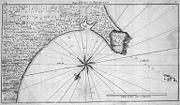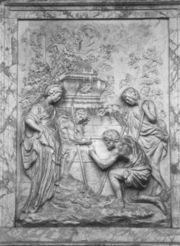
Shugborough Hall
Encyclopedia

Great Haywood
Great Haywood is a village in central Staffordshire, England, just off the A51 about four miles from Rugeley.Great Haywood lies on the River Trent, where the Trent is met by its tributary, the River Sow...
, Staffordshire
Staffordshire
Staffordshire is a landlocked county in the West Midlands region of England. For Eurostat purposes, the county is a NUTS 3 region and is one of four counties or unitary districts that comprise the "Shropshire and Staffordshire" NUTS 2 region. Part of the National Forest lies within its borders...
, England
England
England is a country that is part of the United Kingdom. It shares land borders with Scotland to the north and Wales to the west; the Irish Sea is to the north west, the Celtic Sea to the south west, with the North Sea to the east and the English Channel to the south separating it from continental...
, 4 miles from Stafford
Stafford
Stafford is the county town of Staffordshire, in the West Midlands region of England. It lies approximately north of Wolverhampton and south of Stoke-on-Trent, adjacent to the M6 motorway Junction 13 to Junction 14...
on the edge of Cannock Chase
Cannock Chase
Cannock Chase is a mixed area of countryside in the county of Staffordshire, England. The area has been designated as the Cannock Chase Area of Outstanding Natural Beauty. The Chase gives its name to the Cannock Chase local government district....
. It comprises a country house, kitchen garden, and model farm. Owned by the National Trust
National Trust for Places of Historic Interest or Natural Beauty
The National Trust for Places of Historic Interest or Natural Beauty, usually known as the National Trust, is a conservation organisation in England, Wales and Northern Ireland...
and maintained by the leaseholder, Staffordshire County Council, it previously belonged to the Earls of Lichfield
Earl of Lichfield
Earl of Lichfield is a title that has been created three times in British history. Lord Bernard Stewart, youngest son of Esmé Stewart, 1st Duke of Lennox, was to be created Earl of Lichfield by Charles I for his actions at the battles of Newbury and Naseby but died before the creation could...
, the Anson family.
History

Dissolution of the Monasteries
The Dissolution of the Monasteries, sometimes referred to as the Suppression of the Monasteries, was the set of administrative and legal processes between 1536 and 1541 by which Henry VIII disbanded monasteries, priories, convents and friaries in England, Wales and Ireland; appropriated their...
and therefter passed through several hands until it was purchased in 1624 by William Anson, a lawyer, of Dunston, Staffordshire
In about 1693 his grandson William Anson (1656–1720) demolished the old house and created a new mansion. The entrance front then to the west, comprised a ballustraded three storey, seven bayed central block . In about 1748 his great grandson Thomas Anson commissioned architect Thomas Wright to remodel the house, which was extended with flanking two storey, three bayed pavilions linked to the central block by pedimented passages. At the turn of the 18th century the house was further altered and extended by architect Samuel Wyatt
Samuel Wyatt
Samuel Wyatt was an English architect and engineer. A member of the Wyatt family, which included several notable 18th and 19th century English architects, his work was primarily in a neoclassical style.-Career:...
, when the pavilions and passages were incorporated into the main building and a new portico
Portico
A portico is a porch leading to the entrance of a building, or extended as a colonnade, with a roof structure over a walkway, supported by columns or enclosed by walls...
ed entrance front with ten Doric order
Doric order
The Doric order was one of the three orders or organizational systems of ancient Greek or classical architecture; the other two canonical orders were the Ionic and the Corinthian.-History:...
pillars was created at the east. for Thomas Anson, the 1st Viscount Anson
Thomas Anson, 1st Viscount Anson
Thomas Anson, 1st Viscount Anson was a British politician and peer.Anson was the son of George Adams, who later changed the family name to Anson in 1773, after inheriting Shugborough Hall from his maternal uncle, Lord Anson...
and his wife Anne Margaret Coke, daughter of Thomas Coke, the 1st Earl of Leicester
Thomas Coke, 1st Earl of Leicester (seventh creation)
Thomas William Coke, 1st Earl of Leicester , known as Coke of Norfolk, was a British politician and agricultural reformer. Born to Wenman Coke, Member of Parliament for Derby and his wife Elizabeth, Coke was educated at several schools, including Eton College, before undertaking a Grand Tour of...
, whom he married in 1794. Styled Viscountess Anson in 1806, Anne Margaret Coke Anson died in London in 1843 and was buried at Shugborough.
Around 1750 the architect James "Athenian" Stuart
James Stuart (1713-1788)
James "Athenian" Stuart was an English archaeologist, architect and artist best known for his central role in pioneering Neoclassicism.-Early life:...
, created a number of follies and monuments in the grounds. These include the Tower of Winds (based on one in Greece
Tower of the Winds
The Tower of the Winds, also called horologion , is an octagonal Pentelic marble clocktower on the Roman agora in Athens. The structure features a combination of sundials, a water clock and a wind vane...
), the Chinese House (a Chinese-style
Chinoiserie
Chinoiserie, a French term, signifying "Chinese-esque", and pronounced ) refers to a recurring theme in European artistic styles since the seventeenth century, which reflect Chinese artistic influences...
pagoda), a triumphal arch based on Hadrian's
Arch of Hadrian
The Arch of Hadrian is a monumental gateway resembling – in some respects - a Roman triumphal arch. It spanned an ancient road from the center of Athens, Greece, to the complex of structures on the eastern side of the city that included the Temple of Olympian Zeus...
, a Doric
Doric order
The Doric order was one of the three orders or organizational systems of ancient Greek or classical architecture; the other two canonical orders were the Ionic and the Corinthian.-History:...
Temple, the Cat's Monument, and the Shepherd's Monument.
The grounds are connected to the village of Great Haywood
Great Haywood
Great Haywood is a village in central Staffordshire, England, just off the A51 about four miles from Rugeley.Great Haywood lies on the River Trent, where the Trent is met by its tributary, the River Sow...
by the Essex Bridge
Essex Bridge, Staffordshire
Essex Bridge is a Grade I listed packhorse bridge over the River Trent near Great Haywood, Staffordshire, England.Lying on the River Trent one hundred yards downstream of the junction with the River Sow, it was built in 1550 by the then Earl of Essex for Queen Elizabeth I so that when she visited...
, built in the Middle Ages, and contain numerous sculptures in addition to Stuart's follies.
Nearby is Milford Hall
Milford Hall
Milford Hall is a privately owned 18th-century country mansion house at Milford, near Stafford. It is the home of the Levett Haszard family and is a Grade II listed building....
, the estate of the Levett
Levett
Levett is an Anglo-Norman territorial surname deriving from the village of Livet-en-Ouche, now Jonquerets-de-Livet, in Eure, Normandy. Ancestors of the earliest Levett family in England, the de Livets were lords of the village of Livet, and undertenants of the de Ferrers, among the most powerful of...
Haszard family, who are related to the Ansons and who sit on the board at Shugborough.
Family History

Great Haywood
Great Haywood is a village in central Staffordshire, England, just off the A51 about four miles from Rugeley.Great Haywood lies on the River Trent, where the Trent is met by its tributary, the River Sow...
, Staffordshire produced some famous men, including Admiral George Anson, 1st Baron Anson
George Anson, 1st Baron Anson
Admiral of the Fleet George Anson, 1st Baron Anson PC, FRS, RN was a British admiral and a wealthy aristocrat, noted for his circumnavigation of the globe and his role overseeing the Royal Navy during the Seven Years' War...
, George Anson (British soldier), General George Anson (1769-1849)
George Anson (1769-1849)
General Sir George Anson, GCB, KTS , commanded a British cavalry brigade under the Duke of Wellington during the Peninsular War and sat for many years as a Member of Parliament.-Early life:...
, Thomas Anson (MP)
Thomas Anson (MP)
Thomas Anson , FRS was a British Member of Parliament, traveller and amateur architect.Anson was the son of William Anson and Isabella Carrier, sister-in-law to the Thomas Parker, 1st Earl of Macclesfield. The family estate was Shugborough Hall in Staffordshire...
, Dean of Chester Frederick Anson and his sons George Edward Anson
George Edward Anson
George Edward Anson was a courtier and British politician. He served as Keeper of Her Majesty's Privy Purse, Treasurer of the Household to HRH Prince Albert, Treasurer and Cofferer of the Household of HRH the Prince of Wales, a member of the Council of the Duchy of Lancaster and of the Prince of...
and Frederick Anson
Frederick Anson
The Revd Frederick Anson , a fellow of All Souls College, Oxford, served as Canon of St. George's Chapel at Windsor Castle. As such, he was Canon to Queen Victoria...
, Canon of St George's Chapel at Windsor Castle. Seven ships in the Royal Navy have been christened , honouring the first Baron Anson's circumnavigation in the 1740s.
The house contains a collection of photographs by the house's recent resident, the royal photographer, the late Patrick Anson, 5th Earl of Lichfield (1939-2005). Through his mother Anne (1917–1980)
Princess Anne of Denmark
Princess Anne of Denmark was the mother of royal photographer Patrick Anson, 5th Earl of Lichfield, and a cousin of Elizabeth II of the United Kingdom.-Family:...
, he was a first cousin, once removed, of Queen Elizabeth II of the United Kingdom
Elizabeth II of the United Kingdom
Elizabeth II is the constitutional monarch of 16 sovereign states known as the Commonwealth realms: the United Kingdom, Canada, Australia, New Zealand, Jamaica, Barbados, the Bahamas, Grenada, Papua New Guinea, the Solomon Islands, Tuvalu, Saint Lucia, Saint Vincent and the Grenadines, Belize,...
, his mother having been a niece of Elizabeth Bowes-Lyon
Elizabeth Bowes-Lyon
Elizabeth Angela Marguerite Bowes-Lyon was the queen consort of King George VI from 1936 until her husband's death in 1952, after which she was known as Queen Elizabeth The Queen Mother, to avoid confusion with her daughter, Queen Elizabeth II...
, the late Queen Mother
Queen mother
Queen Mother is a title or position reserved for a widowed queen consort whose son or daughter from that marriage is the reigning monarch. The term has been used in English since at least 1577...
. The 5th Earl of Lichfield married in 1975 Lady Leonora Grosvenor
Leonora Anson, Countess of Lichfield
Leonora Anson, Countess of Lichfield, LVO, was born as Leonora Mary Grosvenor, a daughter of the 5th Duke of Westminster....
, daughter of the 5th Duke of Westminster
Robert Grosvenor, 5th Duke of Westminster
Lieutenant-Colonel Robert George Grosvenor, 5th Duke of Westminster DSO TD JP DL , was a British soldier, landowner, businessman and politician. In the 1970s he was the richest man in Britain....
. After divorcing in 1986, the Countess of Lichfield retained her title and has not remarried.
The Shepherd's Monument

The Holy Blood and the Holy Grail
The Holy Blood and the Holy Grail is a book by Michael Baigent, Richard Leigh, and Henry Lincoln....
drew attention to the mysterious Shugborough inscription
Shugborough inscription
The Shugborough inscription is a sequence of letters - O U O S V A V V, between the letters D M - carved on the 18th-century Shepherd's Monument in the grounds of Shugborough Hall in Staffordshire, England, below a mirror image of Nicolas Poussin's painting, the Shepherds of Arcadia...
. Carved by an unknown 18th-century craftsman, this has been called one of the world's top uncracked ciphertext
Ciphertext
In cryptography, ciphertext is the result of encryption performed on plaintext using an algorithm, called a cipher. Ciphertext is also known as encrypted or encoded information because it contains a form of the original plaintext that is unreadable by a human or computer without the proper cipher...
s. Theories have abounded, including some which suggest it may indicate the whereabouts of the Holy Grail
Holy Grail
The Holy Grail is a sacred object figuring in literature and certain Christian traditions, most often identified with the dish, plate, or cup used by Jesus at the Last Supper and said to possess miraculous powers...
, an idea fuelled by the Anson family's ancestral ties to the Knights Templar
Knights Templar
The Poor Fellow-Soldiers of Christ and of the Temple of Solomon , commonly known as the Knights Templar, the Order of the Temple or simply as Templars, were among the most famous of the Western Christian military orders...
.
In January 2011 the British press revealed that A. J. Morton
A. J. Morton
A. J. Morton is a writer and researcher specialising in the history of the west coast of Scotland. He has been a consultant, contributor or writer for The Sunday Times, Irvine Times, Fortean Times, The Sunday Post, and The Herald....
had solved the code. The letters O.U.O.S.V.A.V.V. & D.M., the Times explained, were probably created for, by, or in memorial of, Viscount Anson and his wife Mary Vernon-Venables.
In recent years, codebreakers from the National Codes Center at Bletchley Park
Bletchley Park
Bletchley Park is an estate located in the town of Bletchley, in Buckinghamshire, England, which currently houses the National Museum of Computing...
in Buckinghamshire have tried unsuccessfully to decipher it. Before them, it is said that Charles Darwin
Charles Darwin
Charles Robert Darwin FRS was an English naturalist. He established that all species of life have descended over time from common ancestry, and proposed the scientific theory that this branching pattern of evolution resulted from a process that he called natural selection.He published his theory...
and Charles Dickens
Charles Dickens
Charles John Huffam Dickens was an English novelist, generally considered the greatest of the Victorian period. Dickens enjoyed a wider popularity and fame than had any previous author during his lifetime, and he remains popular, having been responsible for some of English literature's most iconic...
also tried, and similarly failed.
Numerous explanations have been put forward, linking the code to the Priory of Sion
Priory of Sion
The Prieuré de Sion, translated from French as Priory of Sion, is a name given to multiple groups, both real and fictitious. The most notorious is a fringe fraternal organisation, founded and dissolved in France in 1956 by Pierre Plantard...
, the Holy Grail
Holy Grail
The Holy Grail is a sacred object figuring in literature and certain Christian traditions, most often identified with the dish, plate, or cup used by Jesus at the Last Supper and said to possess miraculous powers...
and UFO's.
One more modest and romantic theory being that of a secret message between two lovers.
Noted guests

J. R. R. Tolkien
John Ronald Reuel Tolkien, CBE was an English writer, poet, philologist, and university professor, best known as the author of the classic high fantasy works The Hobbit, The Lord of the Rings, and The Silmarillion.Tolkien was Rawlinson and Bosworth Professor of Anglo-Saxon at Pembroke College,...
, author of The Lord of the Rings
The Lord of the Rings
The Lord of the Rings is a high fantasy epic written by English philologist and University of Oxford professor J. R. R. Tolkien. The story began as a sequel to Tolkien's earlier, less complex children's fantasy novel The Hobbit , but eventually developed into a much larger work. It was written in...
, stayed in Great Haywood
Great Haywood
Great Haywood is a village in central Staffordshire, England, just off the A51 about four miles from Rugeley.Great Haywood lies on the River Trent, where the Trent is met by its tributary, the River Sow...
during the winter of 1916/17 and in his story 'The Tale of the Sun and the Moon' (The Book of Lost Tales 1
The Book of Lost Tales
The Book of Lost Tales is the title of a collection of early stories by J. R. R. Tolkien, and of the first two volumes of Christopher Tolkien's 12-volume series The History of Middle-earth, in which he presents and analyses the manuscripts of those stories, which were the earliest form of the...
) he writes about a gnome called Gilfanon who owned an ancient house "...the House of a Hundred Chimneys, that stands nigh the bridge of Tavrobel". Tavrobel he describes a village near the confluence of two rivers. If you stand on the Essex Bridge
Essex Bridge
Essex Bridge may refer to:* Essex Bridge, Staffordshire* Essex Bridge , Dublin, Ireland...
, you can see where the river Sow meets the river Trent; and Shugborough Hall has about 80 chimneys.
Another fantasy author, Mark Chadbourn
Mark Chadbourn
Mark Chadbourn is an English fantasy, science fiction and horror author with fifteen novels published around the world.Born in the English Midlands from a long line of coal miners...
, features Shugborough and the mysterious bas-relief on the Shepherd's Monument in his novel The Hounds of Avalon, part of The Dark Age sequence. In the novel, the gardens provide a point of access to the magical Otherworld of Celtic mythology.
Nicolas Poussin
Nicolas Poussin
Nicolas Poussin was a French painter in the classical style. His work predominantly features clarity, logic, and order, and favors line over color. His work serves as an alternative to the dominant Baroque style of the 17th century...
's Arcadia and the inscription also figure prominently in the fiction work by Steve Berry, The Alexandria Link. They are used to find the location of the Library of Alexandria
Library of Alexandria
The Royal Library of Alexandria, or Ancient Library of Alexandria, in Alexandria, Egypt, was the largest and most significant great library of the ancient world. It flourished under the patronage of the Ptolemaic dynasty and functioned as a major center of scholarship from its construction in the...
.
The Present Day
The estate was gifted to the National Trust by the Anson family in 1960 in lieu of death duties: it is managed on behalf of the owners by the Staffordshire County Council. The family resided in private apartments in the house until April 2010. Following the death of Patrick Lichfield on 11 November 2005 the private apartments were opened to the public in March 2011 where they can be viewed during a visit to the house.The grounds and mansion house are open to the public. The attraction is marketed as "The Complete Working Historic Estate", which includes a working model farm museum dating from 1805 complete with a working watermill
Watermill
A watermill is a structure that uses a water wheel or turbine to drive a mechanical process such as flour, lumber or textile production, or metal shaping .- History :...
, kitchen
Kitchen
A kitchen is a room or part of a room used for cooking and food preparation.In the West, a modern residential kitchen is typically equipped with a stove, a sink with hot and cold running water, a refrigerator and kitchen cabinets arranged according to a modular design. Many households have a...
s, a dairy
Dairy
A dairy is a business enterprise established for the harvesting of animal milk—mostly from cows or goats, but also from buffalo, sheep, horses or camels —for human consumption. A dairy is typically located on a dedicated dairy farm or section of a multi-purpose farm that is concerned...
, a tea room, and rare breeds of farm animals. The walled garden
Walled garden
A walled garden is specifically a garden enclosed by high walls for horticultural rather than security purposes, though traditionally all gardens have been hedged about or walled for protection from animal or human intruders...
, also dating from 1805, was restored in 2006 and also forms part of the attraction.
In addition, the house contains the historic servants' quarters and, within these, a Brewery. Originally restored in 1990, this is England's only log-fired brewery that still produces beer commercially, through a partnership with a local brewery. Previously used only on special occasions, the brewhouse has been a working exhibit since 2007.
External links
- Official website of Shugborough
- Memorial service for Patrick Anson
- Shugborough Garden - information on garden history and design
- Shugborough information at the National Trust
- Stafford Tourism Bureau
- The Return of The Christ?
- "Lord Lichfield's photographs to go on display at Shugborough Hall", Maev Kennedy, The GuardianThe GuardianThe Guardian, formerly known as The Manchester Guardian , is a British national daily newspaper in the Berliner format...
, Retrieved 03-18-2011

